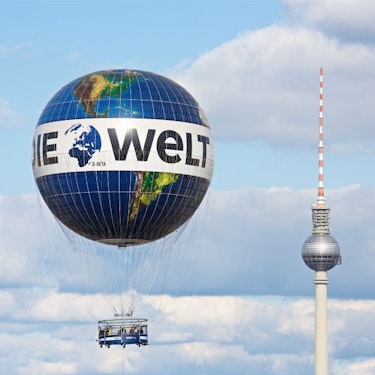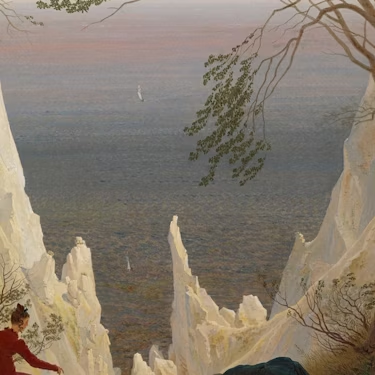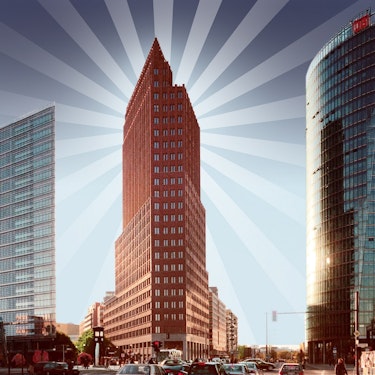More about: Berlin in 7 Days: everything you need to know
When you're preparing your trip, you'll realise that there's a lot more to see in Berlin than the remains of the Berlin Wall and the Brandenburg Gate. The city is the largest in Germany and, more importantly, it has so much history that almost every corner of the city has something interesting to offer. It is also a city with a different atmosphere, which is reflected in many of its neighbourhoods.
A visit to the Museum Island alone could take several days, although it is usually a half-day visit. Its more alternative neighbourhoods are also worth a leisurely stroll, and if that wasn't enough, nearby is a city as interesting and worth seeing as Potsdam. All of this is included in this 7-day itinerary, but you should always be flexible in case you feel like changing something as you go along.
Day 1: Introduction to the city and tour of historic Mitte
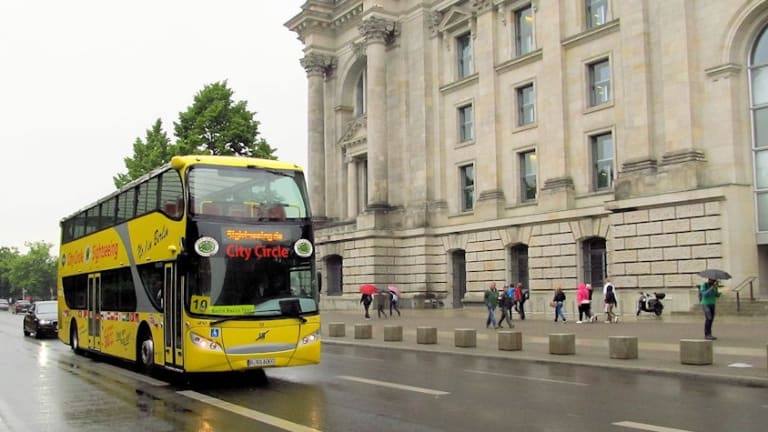
When you arrive in a new city there is always a certain amount of confusion at first. It usually takes some time to get to know the city and get to know the ins and outs of it. It is a great idea to take a short guided tour of Berlin or take advantage of the sightseeing bus.
The rest of the day will be taken up with a tour of what is known as the historic Mitte. There are many places to see in this area, but as they are all very close together it is easy to get to each one on foot.
Start your trip with a tour on a sightseeing bus
To start getting to know the city, you can choose to hire a small guided tour or get on one of the tourist buses that travel around Berlin. In this case, I recommend you start with the latter option.
Given that there are several types of bus tours, it is best to opt for one that passes through the most representative places, such as Checkpoint Charlie, the Brandenburg Gate or the Reichstag.
Obviously, you will have the opportunity to visit them all later at your own pace and on foot, but the tourist bus will serve as a great first contact with the history of the city.
See the Reichstag and climb the Reichstag dome
To start your tour of historic Mitte, right in the centre of Berlin, there are few places more representative than the Reichstag. The building dates back to 1894, when it was built to serve as the seat of the German Parliament in the imperial era.
There are few places that have experienced as much history in Europe as this building: from the end of the German monarchy to the 1933 fire that was used as an excuse by the Nazis to declare dictatorship.
The best place to contemplate its stupendous neo-Renaissance façade is on the meadow in front of it. When you're done, get ready to go up to the roof and enjoy fabulous views from the glass dome.
Going up to the dome is free, but requires a pre-booking on the website. This article on tickets to the Reichstag has all the information you need.
Admire the Brandenburg Gate and Pariser Platz

Next to the Reichstag you will find one of the symbols of Berlin: the Brandenburg Gate. When it was built in the time of Wilhelm II of Prussia, it was one of the 18 gates through which people entered Berlin.
During the partition of the city with the wall, this gate was left in no man's land, but later became an emblem of reunification.
The square at the foot of the gate, the Pariser Platz, was the place chosen by the bourgeoisie to celebrate their parties. Rebuilt after the Second World War, if you go to Berlin at Christmas time you'll see how the area fills up with thousands of people celebrating the arrival of the new year.
The Holocaust Memorial: a place for meditation
From the Brandenburg Gate you only have to walk a few minutes around the Adlon Hotel to reach one of Berlin's most significant landmarks: the Holocaust Memorial. Dedicated to the Jews murdered during the Nazi era, it is a kind of labyrinth created by concrete blocks of different heights.
If you visit this place, please behave respectfully, as in recent years there has been a proliferation of attitudes not in keeping with the sad significance of the site.
For those who want to delve deeper into history, there is an underground exhibition under the memorial explaining the persecution of the Jews.
Take a leisurely stroll along Friedrichstrasse
In the eastern part of the Mitte is Friedrichstrasse, an avenue that runs perpendicular to Unter der Linden. Many of the buildings you'll see here are relatively new, as the area was destroyed by bombing during World War II.
Today, the street is home to numerous shops and shopping centres, making it an ideal place to stop for a shopping spree.
Gendarmenmarkt, one of Berlin's most beautiful squares

You can't visit historic Mitte without stopping at this square. As its name, Gendarmenmarkt (Gendarmenmarkt) indicates, it was originally the place where a Prussian regiment of Huguenots who fled from France to Berlin, the so-called Gens d'armes, took refuge.
In the square you can see the Konzerthaus, a beautiful concert hall dating from 1821. Also, don't miss a visit to the twin churches located there: the Französicher Dom and the Deutscher Dom.
The place where books used to be burnt: Bebelplatz
Very close to the previous one you will find another square which, in addition to its buildings, stands out for its role in the history of the 20th century.
On Bebelplatz you will find four extraordinary examples of the city's architecture. The State Opera, St. Hedwigs Cathedral, the Old Royal Library and the present-day Humboldt Universitat are sure to impress.
However, the square became most famous for being the site chosen by the Nazis, specifically their Student League, to carry out the first allegedly subversive book burning in 1933.
Day 2: Museum Island, Unter den Linden and Tiergarten Garden

The second day of your trip starts with a visit to the Museum Island. Bear in mind that only one morning is not enough time to see everything, but on a trip it is always necessary to make some choices.
So, if you are an art lover, you can always extend your visit or come back at any other time to finish it.
Immerse yourself in the art on Museum Island
When you're done with the museums, I suggest you head to this great avenue. It can also be a great place to grab a bite to eat.
The history of Unter den Linden began in the 16th century, when King John George I decided to create a path linking his palace to Tiergarten, then a hunting ground.
Today, the renovated avenue (as it was severely damaged in the war) has several important buildings and monuments. Among those not to be missed on your walk are the German History Museum, the statue of Frederick II the Great and the New Guard building.
Enjoy the nature of Tiergarten
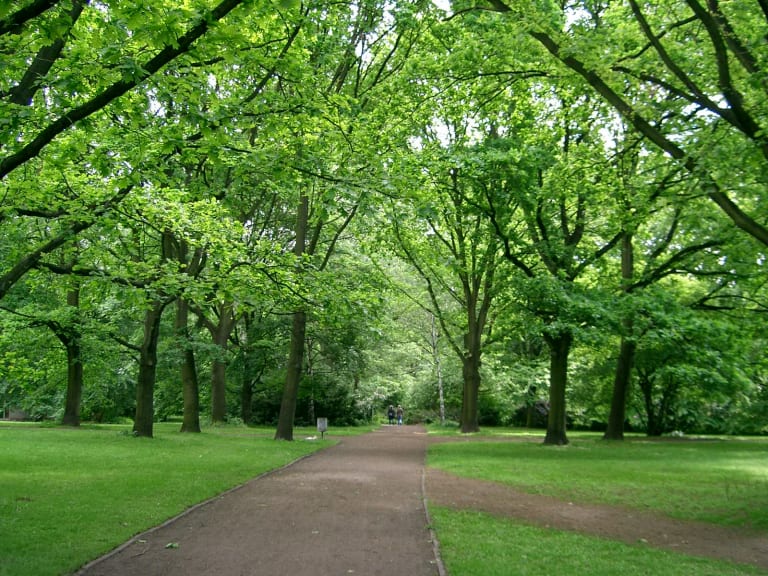
The last point of the tour of a day marked by museums is going to be Tiergarten, a large park of about 3 kilometres. Inside the park there are many possible routes, terraces and a Biergarten, perfect for relaxing with a beer if you've been to Berlin in summer.
The main route through the park is the 17th June Street, famous for being used by Hitler for his military parades. However, the paths leading off from it are much more interesting and you will also find attractions such as the following:
-
Monument to the Gypsies: this monument pays homage to the often forgotten thousands of Gypsies murdered by the Nazis.
-
Soviet Monument: very close to the previous one, this monument commemorates the Soviet soldiers who fought against the Nazis. Under its columns lie the remains of 2000 of these soldiers who died liberating Berlin.
(Siegessäule): another of the most emblematic monuments of the city.
- Bellevue Palace: this is an interesting palace located inside the park.
Dinner at the Tiergartenquelle
This place is a little secret of the city to eat good German food. It's a tavern with a rather rustic décor, with traditional dishes such as pork knuckle or Berliner Bouletten (a type of hamburger).
It's located under the Tiergarten S-Bahn station and it's really worth accompanying your dinner with a mug of beer.
Day 3: Alternative and multicultural Berlin

If you've decided to spend a few days in Berlin you may already be aware of the reputation that some of Berlin's neighbourhoods enjoy as places where alternative lifestyles flourished.
The most important areas in this respect are Kreuzberg, Kulturforum and, to a lesser extent, Potsdamer Platz. You can visit these areas on your own or combine your bike tour with a bike tour of Berlin dedicated to alternative, multicultural and modernist Berlin.
The modernity of Potsdamer Platz
Actually, the name Potsdamer Platz refers to an entire district and not just a square. After being destroyed in World War II and then divided by the Berlin Wall, the area was completely changed by reunification.
Some of the best-known architects of the time were involved in the reconstruction, which is reflected in the beautiful buildings.
Stroll along the Boulevard of Stars
Leaving Potsdamer Platz in the direction of the Kulturforum, you'll see the Boulevard der Stars, a Hollywood-style walk of fame.
Although it's close to where the Berlin Film Festival is held, the stars that line the boulevard are dedicated to **Germany'**s leading actors and filmmakers. If you're a film buff, you can have a great time trying to find out their names.
Also, a series of cameras are installed on this walk so that, looking through their lenses, you can see holograms of the actors featured on the stars.
The museums of Kulturforum

In the 1950s, the Federal Republic of Germany ordered the construction of a series of buildings to house cultural institutions that had been left on the eastern side after the construction of the wall, such as the Museum Island.
The result was the Kulturforum, which still houses museums for all tastes, including some of the best museums in Berlin (with the exception of those on the island, of course). If you fancy a visit, you can choose from the following:
-
Neue Nationalgalerie (New National Gallery): dedicated to modern art.
-
Gemäldegalerie (Gemäldegalerie): houses European paintings of all times.
-
Kunstgewerbemuseum: Museum of Arts and Crafts.
-
Berlin Philharmonic.
-
National Library.
Kreuzberg and its urban life
The highlight of the day is undoubtedly a visit to the Kreuzberg district, also known as **Berlin'**s Turkish quarter.
This is where the city's squatters' movement was born in the 60s and 70s of the 20th century. The atmosphere after the fall of the wall has changed a lot, but it has maintained its multicultural and protesting essence.
On the west side you'll find a large number of cafés and shops with a hipster feel, while the east side concentrates a large part of the city's population of Turkish origin. This is reflected in the number of (high-quality) kebabs you'll find.
One activity you might like to do is to follow the so-called graffiti route. Don't think that this is just graffiti littering the streets. On the contrary, many of them are genuine works of art protected by the city council.
Get to know the dark side of mankind on the Topography of Terror
Still in the Kreuzberg district you will find one of those places that would be better if they didn't exist: the Topography of Terror.
This museum is one of the most visited in the city and is located in the former headquarters of the Gestapo, the sinister Nazi secret police. You can already imagine that inside you will be able to discover the tactics used by this repressive body, as well as find out who its leaders were and their history.
Enter the Jewish Museum

Very close to the previous one is another interesting museum, this time dedicated to a community that was a victim of the Gestapo and the Nazis: the Jews.
The museum tells the history of this people since its members arrived in Berlin in the Middle Ages. Of course, there are also testimonies of the deportations and the Holocaust at the hands of the Nazis.
Night in Kreuzberg
Kreuzberg is also known for being one of the most lively nightlife districts in the city. It is, therefore, the best place to find a place to dine and, if you feel like it, have a drink and enjoy the Berlin nightlife.
In the neighbourhood you'll find all kinds of venues, from techno clubs to cafés where you can sit more quietly, not forgetting the perfect open-air terrace if the weather is nice.
Day 4: From the famous Alexanderplatz to the hidden Nikolaiviertel

This day will start with one of Berlin's best known and most popular areas, Alexanderplatz, and continue with another equally interesting but much more overlooked by most visitors. This way, your trip won't just stay in the most touristy areas, but will also take in other interesting parts of the city.
The city's most famous square: Alexanderplatz
Like many other parts of the city, this part of the city was destroyed after World War II. In rebuilding it, East Germany chose to give Alexanderplatz a style based on Soviet modernism, which is still evident in its buildings.
If you get off at Alexanderplatz station, the first thing you'll see is a huge clock, built in 1969. Over time, it has become one of the typical places where Berliners hang out.
Climb, if you don't have vertigo, the TV Tower (Fernsehturm)
If there's one thing that's clearly visible on the square, it's the huge TV tower. As a curiosity, its silhouette is inspired by the first Soviet space rocket, Sputnik.
It is 250 metres high and has a 118-metre antenna. At 203 metres there is a sphere with a viewing platform that can be climbed. If the weather is not bad, you will have a 360º perspective of the whole city.
Visit St. Marienkirche Church
The next stop on the tour is St. Mary's Church, one of the oldest in the city.
While its interior is considered one of the finest examples of Baltic Gothic in the world, its interior is notable for a wonderful fresco depicting the dance of death. Don't miss its beautiful alabaster pulpit either.
Neptunbrunnen and Berlin City Hall
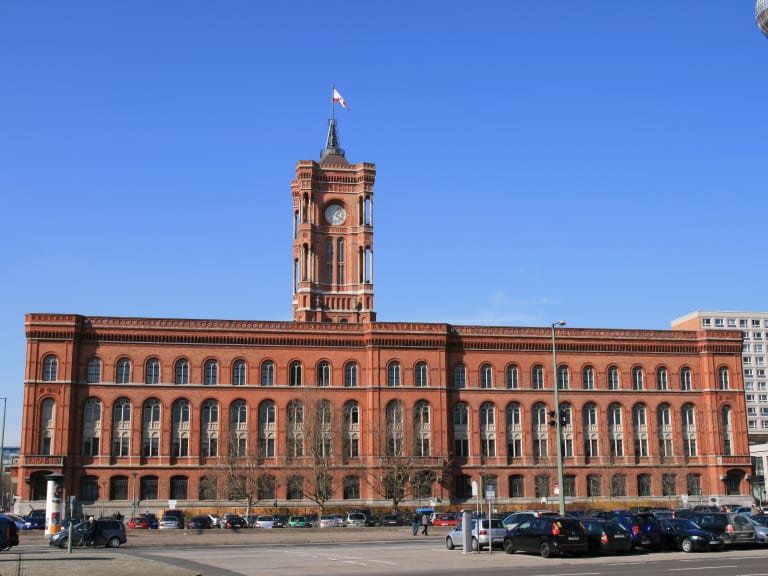
The next points of interest are the Neptune Fountain (Neptunbrunnen) and the nearby City Hall.
The former is really worth spending some time contemplating the details that adorn it. The main statue represents, of course, the god of the sea, Neptune. His figure is surrounded by four women symbolising the country's main rivers: the Rhine, the Oder, the Vistula and the Elbe.
The town hall, meanwhile, is an interesting and unusual blend of Italian Renaissance and North German architecture. Although it is not possible to enter, it is worth discovering the depiction of various historical events in the terracotta frieze.
Enter the city's oldest quarter: Nikolaikirche
The best place to start your visit to this quarter is the church that gives it its name, the Church of St. Nicholas. It was built in 1230 and today houses a museum that exhibits its history and that of the whole neighbourhood.
After leaving this church behind, you can spend some time in one of the nearby museums, such as the Ephraim Palace (with exhibitions on the art of the city) or the interesting Zille Museum, where you can see the work of the so-called chronicler of Berlin courtyards, Heinrich Zille.
If you are a little tired of seeing museums, another good option is to continue walking until you reach the river Spree. There you will find one of the most beautiful squares in the whole area, presided over by a statue showing St George slaying the dragon.
Admire the buildings of Molkenmarkt
Once you arrive at the Molkenmarkt square you will be able to see two interesting buildings. The first is the former mint, the Alte Münze, now an event centre. Opposite is the old town hall, with an 87-metre tower crowned by a statue of the goddess of fortune.
To finish the walk through the district, you can make a short stop at Franziskaner-Klosterkirch, the ruins of a former Franciscan convent. If you are lucky, you may come across one of the concerts that are usually organised in the area.
If you're not already tired, you can take a 20-minute walk to the Brandenburg Gate to see the beautiful lighting and have dinner in the area.
Day 5: Excursion to Potsdam

Near Berlin, just 30 kilometres away, is the beautiful city of Potsdam. For this day I recommend a day trip to see all the sights.
To get to Potsdam from Berlin you can easily take the train. This transport is included in the Berlin Welcome Card, but if you don't have the card the price is no more than 4 € each way.
Nauener Tor
This is one of the old gates through which people used to enter Potsdam. Dating from 1755, it was linked to the other two gates by a wall of which little remains today.
Dutch Quarter
The name of this popular area comes from the Dutch-style red-brick houses that can be found here. These were built by craftsmen from the Netherlands during the reign of Frederick William I of Prussia.
The area is full of cafés, restaurants and shops, so it is always very busy.
In this neighbourhood you will also find the church of St. Peter and St. Paul, very close to a house in which Mozart lived and which you can visit.
The next place to visit is the Old Market Square, the most important square in the old part of Potsdam. Walking around it you will be able to see interesting buildings such as the Barberini Palaceor the Lutheran church of St. Nicholas.
Sanssouci Palace
Without a doubt, this palace is the star of any visit to Potsdam. If you don't go inside, at least its large gardens are worth a leisurely stroll.
With a rococo style and impressive interior decoration, if you feel like it you can go inside and feel like Frederick II of Prussia, who used the palace as his summer residence.
Other interesting sights
In addition to the Sanssouci Palace and its beautiful gardens and the Dutch quarter, you should not miss other places such as the Russian quarter and the cathedral.
I also recommend that you go outside the old town to see interesting sites such as the Cecilienhof Palace (where the Potsdam Conference was held) and the Spy Bridge, famous for being the place where both sides exchanged spies they had captured during the Cold War.
Day 6: A small cruise, the Berlin Wall and the remnants of the GDR

This sixth day, the penultimate day of the trip, will begin with a relaxing activity: a short one-hour cruise.
Afterwards, I have prepared an itinerary to remember some of Berlin's landmarks during the Cold War, starting with a look at the remains of the famous wall that divided the German capital, the country and the whole of Europe in two for several decades.
Cruise on the Spree
After having spent the whole of the previous day visiting Potsdam, there is no better way to start the day than by taking a short cruise on the Spree River on board a boat.
For about an hour you will be able to get a new perspective of some of the main monuments of the city in a relaxed and comfortable way.
Art on the Wall: East Side Gallery
Once you get off the boat you'll have to head for one of the German capital's must-see sites, the East Side Gallery. Here, after the fall of the Berlin Wall, a real work of art was created so that what happened would never be forgotten.
A large number of artists decorated some of the remains of the wall with more than 100 paintings. In addition to their artistic value, they intended to leave a record of the feelings experienced during those days.
These graffiti made this stretch of the wall, more than 1 kilometre long, the best known and most visited of all those that remain.
Experience a spy movie at Checkpoint Charlie
Located on Friedrichstrasse, Checkpoint Charlie was the most famous border crossing between the US and Soviet sectors in the years after the Second World War.
The history of this place is almost unfathomable, something that has been reflected in films on many occasions. After the Wall came down, the border crossing was demolished, but in 2000 a replica of the first one in the city was built.
Tränenpalast, the "Palace of Tears"
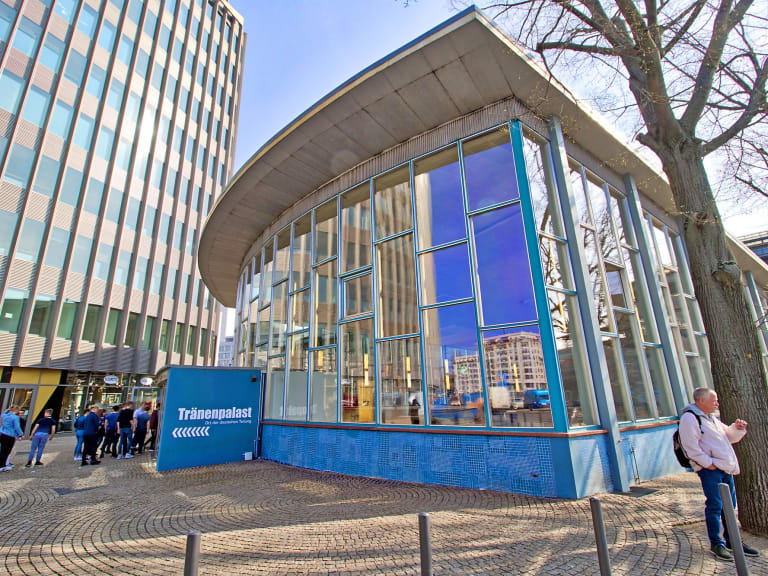
The next stop on the itinerary is another former border crossing between East and West Berlin. This time it is the Tränenpalast, located next to Friedrichstrasse station.
The name of this place can be translated as "palace of tears" and refers to the tears that West Germans shed when they returned home after visiting their relatives in the East.
Inside this place there is an interesting exhibition that you should not miss if you are interested in history. Here you can see some of the original objects that were found at the border crossing point, as well as recreations of the facilities where the administrative and police processes for crossing the border were carried out.
Berlin Wall Memorial
The best place, with the permission of the East Side Gallery, to discover what the Berlin Wall was all about is this memorial, almost a kilometre and a half long.
In the open-air installations, you can learn how all the border crossings were built and in its fantastic graphic exhibition (inside the Documentation Centre) you can see the history of the wall itself and how the city lived during those decades.
A flea market in the former death strip: Mauerpark and Flohmarkt im Mauerpark
Perhaps only a city like Berlin is capable of showing two such different sides of the same place.
Mauerpark (Wall Park) is where the Memorial ends and, during the time when the German capital was divided, it formed part of the section known as the death strip because of the number of people killed in the area when they tried to escape to the west. However, if you go on a Sunday you will find what is a true sample of life in the city today: the Flohmarkt im Mauerpark. This is one of Berlin's most popular flea markets, with stalls accompanied by street music and several beer gardens.
Don't miss the GDR Museum
Another interesting visit for history buffs is the GDR (German Democratic Republic) museum. Although it is not very big, I would definitely recommend a visit.
The exhibition displays a large number of objects of everyday use in communist Germany, from medicines to fashion items, from a typical German car to a reproduction of a house.
Karl-Marx Allee: the great eastern avenue
Before looking for a place to dine, take a stroll along Karl Marx Allee, an imposing 90-metre wide avenue that connects Alexanderplatz with Frankfurter Tor.
This huge artery was built in East Berlin in the 1960s. Here you will find some of the most representative examples of East German architecture.
The houses were intended for prominent party members and the street was the chosen venue for a large number of military parades.
Day 7: Underground tour of Berlin and end in Charlottenburg

Berlin's underground, as in many large cities, hides interesting secrets that are well worth a visit. The Berliner Unterwelten association, which organises various interesting underground tours to suit all tastes, was set up years ago to help you discover them.
In this case, I suggest you take one about the **city'**s nuclear bunkers, but if you look at their website you'll find more options.
The association's office is next to Gesundbrunnen metro station and is the place from which almost all the tours depart.
On the other hand, the day and the trip will end with a tour of one of the most interesting areas of Berlin, Charlottenburg.
Cold War nuclear bunkers
This tour shows how the FRG (Federal Republic of Germany) prepared for a possible nuclear war during the Cold War years.
During the tour you will visit two shelters originally built during the Second World War, but which after the partition of the city were converted to provide shelter for those affected by a hypothetical atomic conflagration.
The most curious thing is that one of these bunkers is still operational and could accommodate just over 3000 people if necessary. The shelter has a water supply system, access control and an emergency power generator.
Get to know one of the gems of the West: Charlottenburg Palace
Visitors to Berlin often focus on the eastern part of the city. While it is true that this is the area with the most attractions, the west also has some interesting sights.
To end the trip it is a good idea to visit Charlottenburg, one of the city's most exclusive districts. Many of the old palaces have been converted into museums or art galleries and its avenues are full of shops, some of them luxury brands.
The Charlottenburg Palace is undoubtedly one of the places you can't miss if you visit this neighbourhood. If you have been to Paris, you will recognise the clear influence of Versailles in its construction, although you will also see other styles in the parts that were added during its history.
If you don't feel like visiting the interior, I do recommend that you at least enter the gardens for a good walk around them.
The hidden gems in the Berggruen Museum

Almost opposite the palace you'll find a pair of beautiful twin buildings built in the 19th century. Both originally served as barracks for the Palace Guard Corps and are now home to two museums.
The most interesting of these is undoubtedly the Berggruen Museum in the Stüler West building. Surprisingly little recognition is given to its collection, as it houses works by great painters such as Picasso, Paul Klee and Matisse.
The other building, the Sammlung Scharf-Gerstenberg, is entirely devoted to surrealist art. Depending on your taste, you can visit both (there is a combined ticket) or just one of them.
Kurfürstendamm boulevard
The 3-kilometre-long boulevard is lined with shops of all kinds, although the luxury boutiques stand out. The boulevard was once used to travel from the city to the Grunewald forest, the hunting grounds of the nobility. Later, in the 19th century, they tried to turn it into a kind of Champs Elysées.
In addition to strolling along it and stopping for a drink, on Kurfürstendamm you will find the most exclusive boutiques, although if you want to buy a souvenir you will also be able to do so without any problems.

